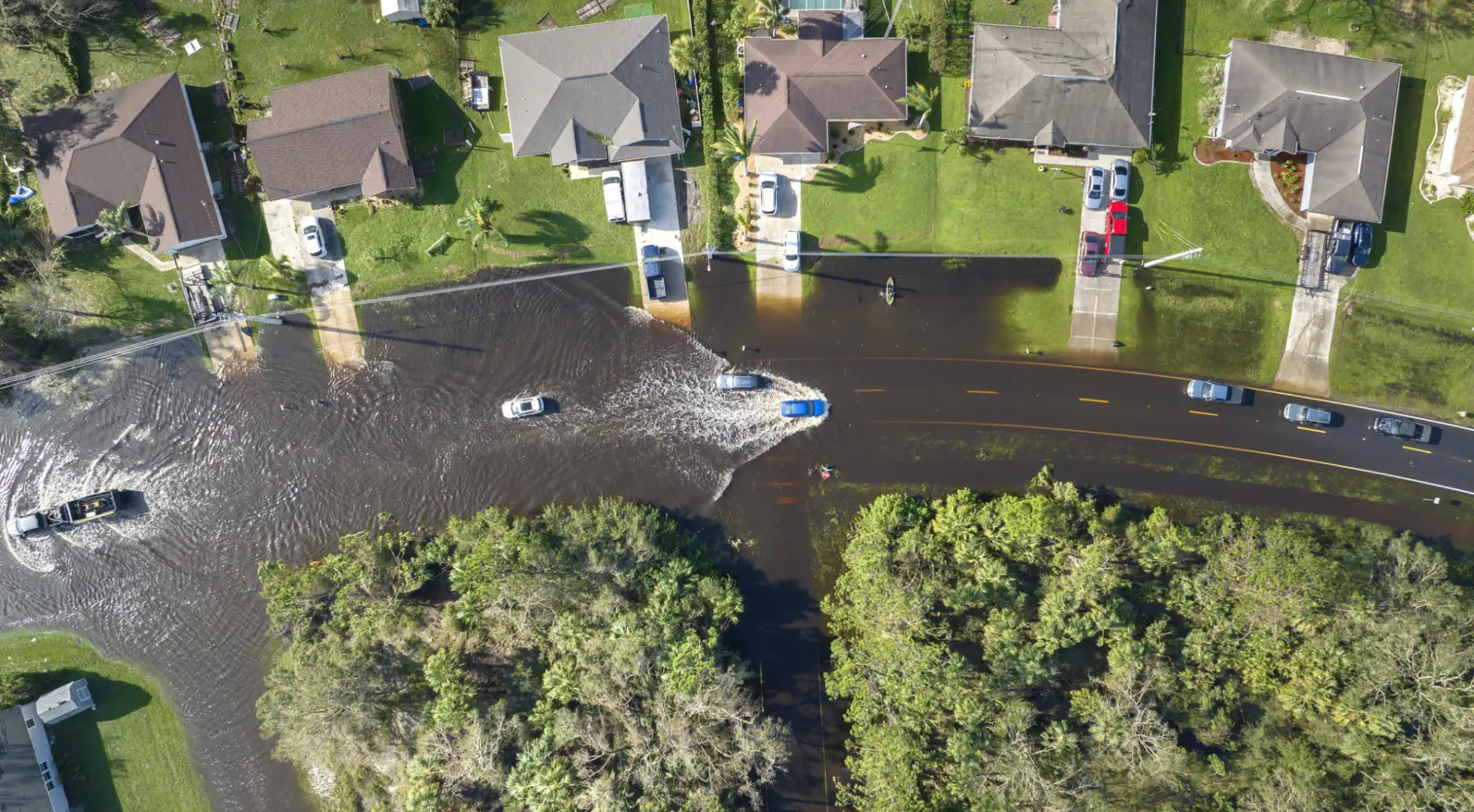Climate Change Risk Checklist & Tools for Homebuyers

What are the chances a flood or tornado will destroy your new home? Many homebuyers want to know.
Fortunately, new tools are making this question easier to answer.
Climate Change Disaster Checklist for Homebuyers
Homebuyers like data: a walkability index, the academic performance of local schools, and what they’ll owe in property taxes.
Now, more homebuyers want to see the odds that a natural disaster will strike their new neighborhood. With the number of extreme weather events increasing dramatically over the past three decades, it’s easy to see why.
The abundance of storms has spiked home insurance rates. In some of the highest-risk areas, insurers won’t approve policies at all. And it’s not all about cataclysmic storms. Extreme heat and rising water levels also make homeownership less predictable.
So before making an offer on your dream home, check whether the property faces high risk for:
1. Floods
In 2023, there were 19 separate severe storm events in the U.S. Thirty years earlier, in 1993, there was only one such event. Many of these severe storms cause flooding.
How to check a property’s flood risk:
Prospective homebuyers can enter a property’s address at sites like Risk Factor, formerly known as Flood Factor. The free version of this site offers basic data about floods, fires, extreme heat, and high winds. Paying for a subscription grants access to more nuanced data, including a property’s climate history.
For less diluted data, check out the Federal Emergency Management Agency (FEMA) flood map to see flood zones near your new property.
2. Wildfires
Homebuyers in many Western states already consider wildfire risks when buying new property. Buyers in other parts of the nation, including the Northeast and Southeast, should also check wildfire data before buying.
The Center for Climate and Energy Solutions anticipates longer and hotter wildfire seasons that affect more acreage in the coming years. The Center bases these projections on extensive data from the U.S. Global Change Research Program.
How to check wildfire risk:
Along with flood data, Risk Factor also includes an assessment of wildfire data.
A similar site, Climate Check, generates a free property-specific report during a free trial period.
3. Sea Level Rise
Beachfront buyers already know to check erosion and rising sea level projections before buying. In future decades, areas miles away from the beach, especially in and around low-lying cities, could be affected by rising sea levels.
How to check sea level risk:
Climate Central’s interactive screening tool shows the effects of rising sea levels on existing coastal geography.
Also, whatsmyelevation.com shows the current elevation of any property’s address. Viewing the site on your smartphone can show elevation as you move around a site.
Remember that most projections show average sea level increases for all properties in a specific area. The actual increase on a single property could be more severe.
4. Extreme Heat
Extreme heat is defined as three consecutive days with highs of at least 90 degrees Fahrenheit accompanied by high humidity. Some parts of the country are experiencing extreme heat for several weeks in a row. This drives up energy and home maintenance costs.
How to check extreme heat risk:
Risk Factor and Climate Check can show a property’s likelihood of prolonged extreme heat.
This interactive map predicts the weather conditions for specific cities in 2080.
5. Tornados
Tornadoes are harder to predict than flooding, rising sea levels, and extreme heat. However, history shows that some areas face these violent storms more than others.
How to check tornado risk:
FEMA’s National Risk Index map can show tornado risks for each county in the U.S. Make sure to select “Tornado” from the Risk Index dropdown menu.
If you’re buying in a high-risk county, be sure the new home has an accessible basement or quick access to another type of safe shelter.
6. Hurricanes
Hurricanes bring dangerously high winds, catastrophic flooding, and tornado threats to coastal areas. Their remnants can then impact areas hundreds of miles inland.
How to check hurricane risk:
FEMA’s interactive map includes hurricane data in its risk index. Be sure to select “Hurricane” from the Risk Index dropdown menu.
7. Earthquakes
There’s no known connection between climate change and earthquake risk. But regardless of what’s happening in the atmosphere, instability beneath the earth’s surface is dangerous for people and their homes.
Some parts of the nation face a higher risk of experiencing an earthquake. Home buyers should always be aware of their neighborhood’s chances of experiencing a dangerous earthquake.
How to check earthquake risk:
This data from FEMA shows earthquake risks throughout the U.S.
Where Else to Find Climate Change Data for Homebuyers
As more homebuyers search for climate data, this type of data has become easier to find. Private companies like Risk Factor and Climate Check package data for realtors, lenders, and buyers.
However, these services rely mostly on data collected by the federal government—data like the FEMA maps, which anyone can access online for free.
Property listing websites like Redfin and Realtor have started adding climate data to their house listings alongside walkability, property tax estimates, and school grades.
Other Interesting Climate Data Tools
EarthData — This NASA tool gives everyone access to the agency’s extensive climate data.
Ocean At The Door – This tool projects the impact of rising sea levels.
Limits Of Climate Data
Climate projections are never 100 percent reliable. It’s hard to predict next week’s rain chances, so how can anyone know, for certain, the future of a single piece of property? They can’t.
But general trends say a lot. Right now, these trends show properties suffer more flooding, extreme heat, and other types of severe weather today than they did 30 years ago. What’s been true in recent decades will likely continue to be true in the coming decades.
Additionally, services like Climate Check and Risk Factor show risks for specific properties, but keep in mind, other properties in the same neighborhood may show an identical risk level, especially for extreme heat, high winds, and wildfires.
Yet, flood risk can vary between properties in the same neighborhood. Even a few feet of elevation could make a huge difference in flood risk.
Check a Property's Insurability Before Buying
Know someone who sells home insurance? If so, you probably know an expert on property risk. Insurance companies have spent decades, sometimes even centuries, paying close attention to climate data, weather trends, and property risks. Predicting risk factors accurately changes their bottom line.
If a home is not insurable by a private insurance company, know it faces drastically high risks from climate disasters. Or, if multiple insurance quotes come in much higher than expected, the property likely faces higher-than-average risk.
Estimated Cost To Insure
Most homes are insurable, but increasing annual premiums to pay for coverage reflect the home’s rising risk for climate disaster. Insurance reflects other risks too — like crime, fire, and personal liability — but climate disasters have become a growing factor in rising premiums.
At least eight states — most in more disaster-prone areas — expect double-digit percentage increases in home insurance premiums in 2024 alone. This is on top of significant increases in the past several years.
How to Limit the Effects of Climate Disasters
Using climate data to choose a less risky property won’t guarantee safety. Bad things can still happen. Your new home may simply be in the wrong place at the wrong time as waters start to rise or a tornado forms nearby.
So what can you do? Along with improving your chances by paying attention to climate data, homeowners should:
Save Now For Higher Costs Later
It’s always been smart to save money for future home repairs. This matters even more now that climate disasters are becoming more common. At least, always have your insurance policy deductible saved up and easy to access. Paying the deductible helps unlock your insurance policy’s protections.
Install Efficient Systems
Efficient HVAC systems, solar panels, water heaters, and appliances cut down energy costs. In places with extreme heat, these savings add up faster. Plus, since more efficient systems run less often, they tend to last longer.
Update Exterior Features
Keeping exterior features in good shape — quality shutters, adequate roofing, good windows — makes the home more ready to endure high winds and hail. If necessary, add insulation between the walls and above the ceiling.
Landscape Appropriately
Planting native trees near the home — or buying a home in a neighborhood with a healthy tree cover — cuts energy costs by shading the home. The AC won’t have to run as long. But ensure trees near the home are healthy enough to withstand high winds. Falling trees can cause serious damage.
Will Homeownership Ever Cost Too Much?
Climate change inflates insurance premiums, requires more maintenance and energy costs, and even renders some homes uninsurable.
Could we ever see a climate in which owning a home costs too much for the average American family? This seems possible, especially since it amplifies existing market stresses like higher interest rates, inventory shortages, and lower savings rates.
But renting won’t avoid this reality. In fact, renters will pay these costs for their landlords through higher rent.
The best solution: use climate data to inform your choices, take steps to make the home efficient and less vulnerable to disaster, and then, find a way to save money on home financing costs.
Buyers can save thousands by comparing at least three different lenders’ mortgage rates.






